Objectives
The first objective of the experiment is to elucidate the formation of a ketone (pinacolone) from alcohol (pinacol) through the process of pinacol rearrangement in the presence of concentrated sulfuric acid, heat, and boiling chips. The second objective of the experiment is to perform the qualitative test of reactants and products using 2,4-DNP, NMR, and IR tests. The third objective is to explain the relevance of vital steps in the procedure that determine the formation of the required product.
Reactions
Pinacol rearrangement is a significant chemical reaction of the experiment. As pinacol is an alcohol (1,2-diol), concentrated sulfuric acid dehydrates it to a ketone. The presence of concentrated acid, boiling chips, and heat provides favorable conditions for pinacol rearrangement to occur. Figure 1 below demonstrates that pinacol rearrangement entails the loss of water molecule and the formation of pinacolone.

The mechanism of pinacol rearrangement involves protonation of one of the alcohol groups in 1,2-diol, and its removal as a water molecule. The resultant molecule has unstable tertiary carbocation, which causes methyl shift in a bid to stabilize it. The primary carbocation then shares the lone pairs of electrons on the remaining alcohol group; hence, leading to the formation of pinacolone (ketone). Figure 2 clearly demonstrates the mechanism of pinacol arrangement.
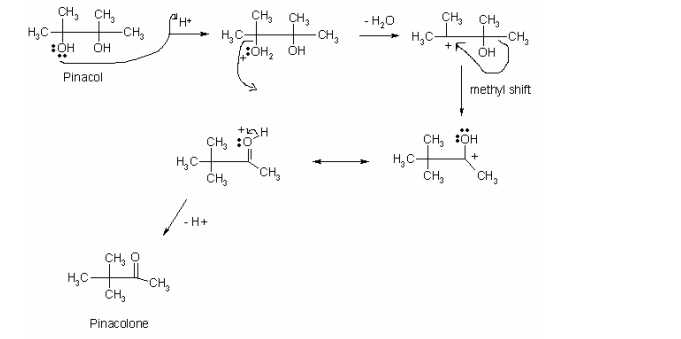
In qualitative analysis of the product formed, 2,4-DNP test can effectively detect if it is a ketone (pinacolone). Figure 3 below is a chemical reaction that shows the reaction of pinacolone and 2,4-DNP to form a yellow precipitate of 2,4-dinitrophenylhydrazone derivative.

Physical Properties of Reactants and Products
Pinacol
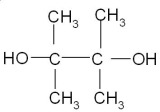
- State: Solid
- Molecular formula: C6H14O2
- Melting point: 40-43°C
- Boiling point: 171-172°C
- Molecular weight: 118.17
- Water solubility: soluble in hot water
- Density: 0.967 g/cm3
- Hazards: Highly flammable and irritant
Sulfuric acid

- State: Liquid
- Molecular formula: H2SO4
- Melting point: 10°C
- Boiling point: 290°C
- Molecular weight: 98.08
- Water solubility: Miscible
- Density: 1.84 g/cm3
- Hazards: Toxic, highly flammable, irritant, and corrosive
Sodium Chloride

- State: Solid
- Molecular formula: NaCl
- Melting point: 801°C
- Boiling point: 1,413°C
- Molecular weight: 58.44
- Water solubility: 360 g/L
- Density: 1.199 g/cm3
- Hazards: Irritant
Sodium Sulfate
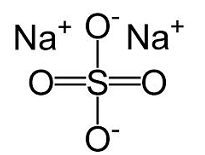
- State: Solid
- Molecular formula: Na2SO4
- Melting point: 884°C
- Boiling point: 1700°C
- Molecular weight: 142.04
- Water solubility: 18.5 mg/L
- Density: 2.68 g/cm3
- Hazards: Irritant
Water

- State: Liquid
- Molecular formula: H2O
- Melting point: 0°C
- Boiling point: 100°C
- Molecular weight: 18.015
- Density: 1 g/cm3
- Hazards: Corrosive
Pinacolone

- State: Liquid
- Molecular formula: C6H12O
- Melting point: -52.5°C
- Boiling point: 106°C
- Molecular weight: 100.16
- Water solubility: 2.44 g/100 mL
- Density: 0.801g/cm3
- Hazards: Harmful, irritant, and highly flammable
2,4-DNP

- State: Solid
- Molecular formula: C6H4N2O5
- Melting point: 108-112°C
- Boiling point: 378°C
- Molecular weight: 184.11
- Water solubility: 0.6 g/100 mL
- Density: 1,683g/cm3
- Hazards: Toxic, irritant, harmful, and highly flammable
Procedure
Formation of Pinacolone
In the formation of pinacol, 3 g of pinacol was measured accurately and was then dissolved in 30 ml of deionized water in 50 ml round-bottom flask. The dissolved pinacol in the flask was immersed in the tap water bath to cool its contents to room temperature. Two boiling chips were added to the flask containing dissolved pinacol followed by the gradual and cautious addition of 5 ml of concentrated sulfuric acid. As the reaction is exothermic, tap water bath was used to cool the reacting contents in the flask. The reacting contents were swirled for 10 minutes to allow completion of reactions.
Subsequently, the flask was connected to a simple distillation apparatus, and the distillate was collected in another 50 ml round-bottom flask. The distillation process was allowed to occur until the temperature of the vapor reached 100°C. 5 ml of the saturated sodium chloride was measured, added to the distillate, and mixed well. The transfer pipette was used to remove the aqueous layer leaving the organic layer in the flask.
The organic layer was dried over anhydrous sodium sulfate, and the dried liquid was poured into a pre-weighed sample vial with a fitting cap. The dried liquid was capped, weighed, and the findings recorded. The percent yield of the products was calculated by comparing actual yield with the empirical yield. The IR, NMR, and 2,4-DNP tests were performed to identify the product formed.
2,4-DNP Test
In the performance of the 2,4-DNP test, 1 ml of 2,4-DNP reagent was measured and placed in a clean and dry test tube. Subsequently, 5 drops of the product were added and then mixed thoroughly with the stirring rod. The observation was made on the color changes and the formation of the precipitate, and eventually, the results were recorded.
- The Calculation of Theoretical Yield and Percent Yield:
- Theoretical yield:
- Mass of pinacol = 3.0 g
- Moles of pinacol = 3.0g/118.17 g/mol= 0.02538 mol
- Since 1 mole of pinacol produces 1 mole of pinacolone, the mole ratio is therefore 1:1
- Therefore, moles of pinacolone = 0.02538 mol
- Theoretical yield = (0.02538 mol*100.16 g/mol)/ 1 mol of pinacolone = 2.542 g
- Percent yield:
- Empty sample vial = 14.5g
- Sample vial + content = 16g
- Actual yield =16-14.5= 1.5
- Percent yield = (Actual/theoretical)*100 = (1.5 g /2.542 g)*100 = 59%
- Theoretical yield:
Synopsis of results
The experiment demonstrated the occurrence of pinacol rearrangement leading to the formation of the product in the presence of heat, concentrated sulfuric acid, and boiling chips. Comparative analysis of the reactant (pinacol) and the product (pinacolone) provides mole ratio, which forms the basis for calculating the percent yield. In this case, the mole ratio of pinacol and pinacolone is 1:1. In this case, theoretical yield indicates that 0.02538 moles of pinacol (3 g) form 0.02538 (2.542 g) moles of pinacolone.
However, the empirical yield shows that 1.5 g of pinacolone, which constitutes 59% of the theoretical yield, was formed instead. The difference between the empirical yield and the theoretical yield emanates from the errors in the experiment process. One of the sources of errors is that some of the pinacol did not undergo rearrangement to form pinacolone. Another possible source of error is that some pinacolone might have evaporated during the process of distillation or decanted with aqueous layer.
Analysis of the IR and NMR spectra provides additional information about the purity of the product formed. Comparison of the IR spectrum of the reactant and the product indicate that they exhibit unique peaks and stretches. The reactant has a broad O-H stretch at 3440.25 cm-1 and C-H stretches at 2984.99 cm-1 and 2942.41 cm-1 (See Figure 4).
Comparatively, IR of the products depicts a notable O=H stretch at 1705.45 cm-1 and C-H stretches at 2942.41 cm-1 and 2773.39 cm-1 (See Figure 5). Analysis of the IR spectrum of the product shows that it does not exhibit O-H stretch between 3200 and 36000 cm-1, which means that there are no traces of pinacol in the product. Moreover, NMR spectrum indicates that chemical shifts of the product are different from that of the reactants (See Figure 6 and 7).
The difference means that the products have not traces of pinacol to retain the pattern of chemical shifts. The melting points of the reactant (pinacol) and the product (pinacolone) indicate that these substances are pure. Pinacol has melting and boiling points of 40°C and 172°C respectively whereas pinacolone has melting and boiling points of -52.5°C and 106°C correspondingly.
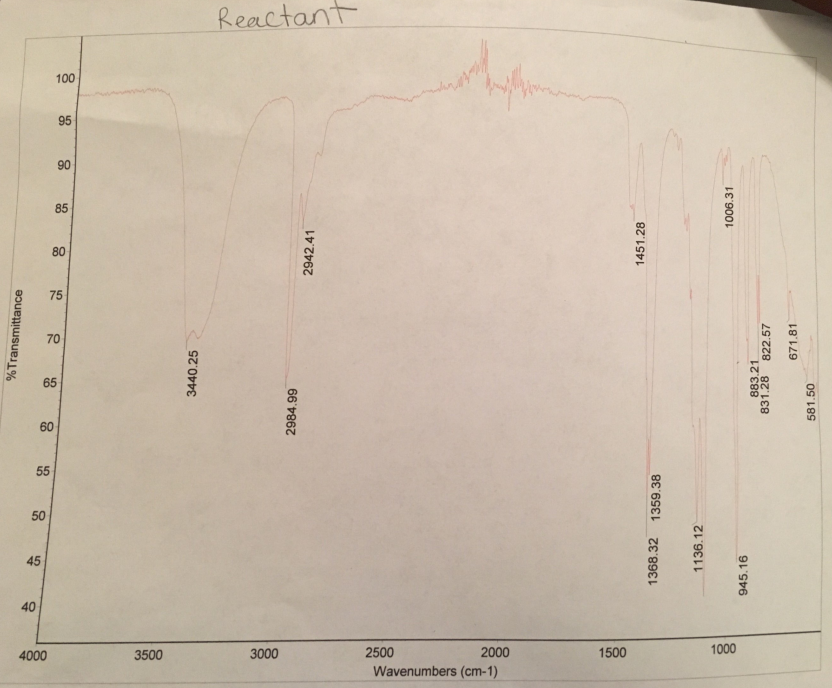
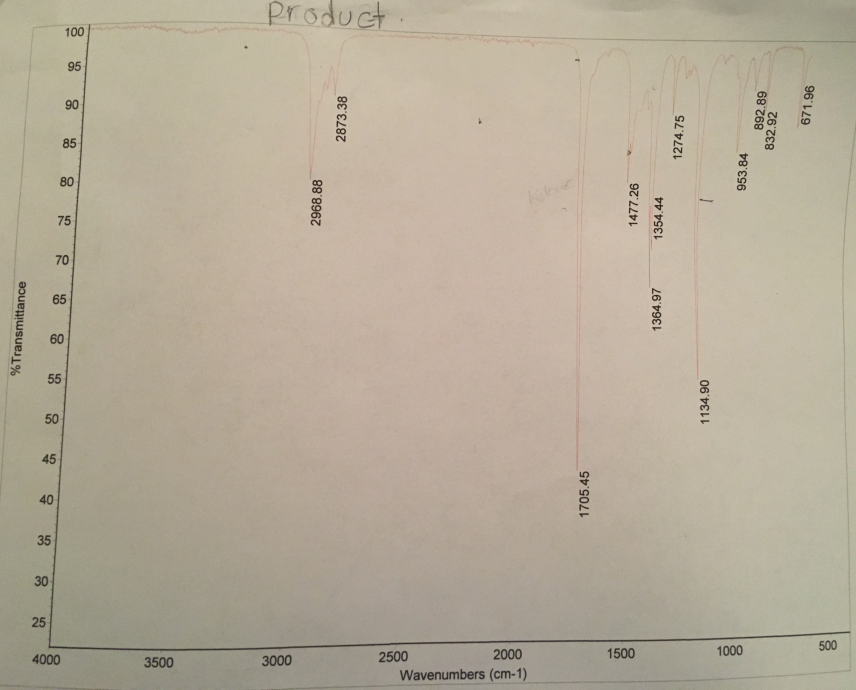
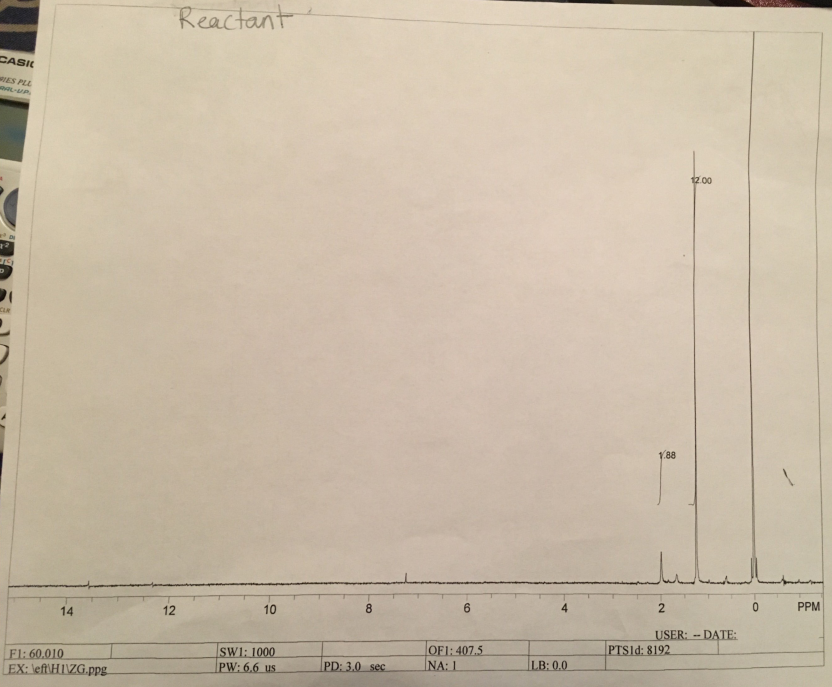
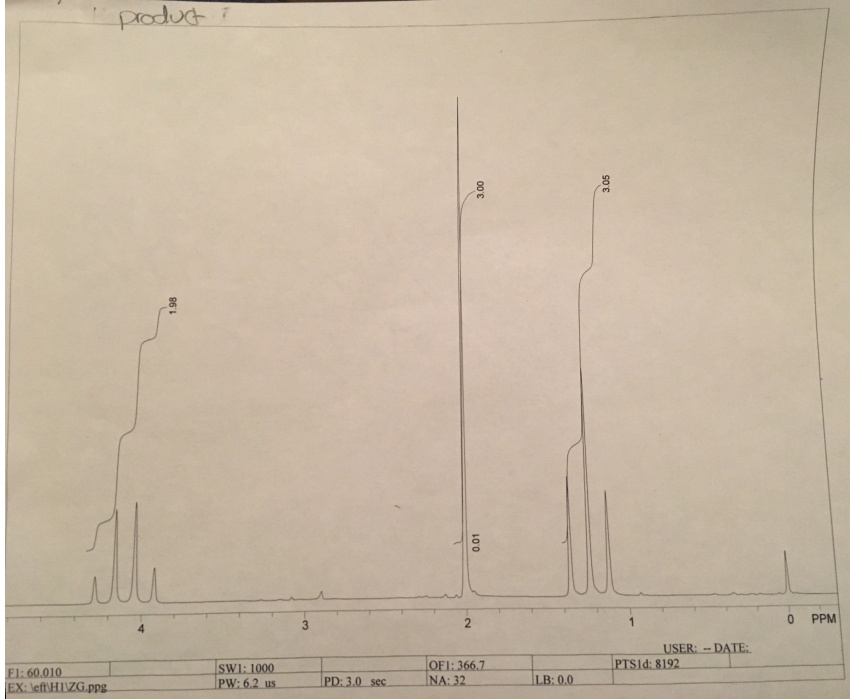
Discussion
The pinacol rearrangement is an important reaction in organic chemistry because it elucidates the mechanism of dehydration of alcohols and methyl shift. This reaction does not occur in 1,2-diols because it entails protonation of one alcohol group and stabilization of tertiary carbocation using the other alcohol group leading to the formation of a ketone. The reaction is notable as pinacol rearrangement because the primary reactant is pinacol (alcohol), which undergoes rearrangement to form pinacolone (ketone). The pinacol rearrangement follows SN1 reaction mechanism where dehydration and stabilization of carbocation happen in a stepwise manner. The process of protonation and methyl shift comprises an exothermic reaction that generates a great deal of heat. Water bath dissipates heat generated and allow pinacol rearrangement to occur at a favorable temperature.
In the experiment, some of the reactants are necessary for the pinacol rearrangement to occur. These reactants are pinacol and sulfuric acid. As pinacol is a solid, the addition of water was needed to allow them to react with concentrated sulfuric acid. The reaction of these reactants resulted in the formation of pinacolone and water. Saturated sodium chloride was added to remove excess water and eliminate inorganic impurities. On the other hand, the products of the reaction are pinacolone and water. The formation of the pinacolone results from the dehydration of pinacol and methyl shift. The dehydration process causes the loss of water as a product while the rearrangement of carbocation and methyl shift lead to the formation of pinacolone. Anhydrous sodium sulfate is a drying agent that removes water distilled with the pinacolone.
The formation of carbocation is central to the mechanism of pinacol rearrangement. When sulfuric acid protonate hydroxyl group (-OH) of the pinacol, it creates oxonium ion (-OH2+), which is a better leaving group than the hydroxyl group (-OH) (Ball 204). When the oxonium ion leaves as a water molecule, it forms a tertiary carbocation. The tertiary carbocation is relatively stable, and the migration of the methyl group enhances its stability. As the tendency of methyl shift increases from primary to tertiary carbocation, the pinacol rearrangement entails methyl shift to stabilize the tertiary carbocation and create carbonyl group.
The carbocation becomes more stable by shifting itself to the carbon atom of the pinacol that contains the second -OH group (Ball 196). The lone pairs of electrons in the -OH group stabilizes carbocation through the process of resonance. The deprotonation of the stabilized pinacol results in the formation of a tertiary carbocation, which drives the methyl shift and causes the formation of the carbonyl group in pinacolone. Figure 2 displays the formation of the tertiary carbocation and its transformation leading to the formation of pinacolone.
For pinacol rearrangement to occur, the reaction requires heat and the concentrated sulfuric acid. Given that alcohols are poor leaving groups in the reactions of alcohols, the addiction of concentrated acids creates good leaving groups. The use of concentrated sulfuric acid generates protons, which protonate the hydroxyl group (-OH) of pinacol in the presence of heat. The protonation creates a good leaving group (H2O+) that is stable and forms a tertiary carbocation. Hydrogen ion (H+) is an electrophile that attacks lone pairs of electrons in the hydroxyl group (-OH) resulting in the formation of a water molecule (H2O). Since the reaction mechanism of pinacol rearrangement follows SN1 mechanism, tertiary carbocation causes the methyl shift to stabilize and create a carbonyl group. Figure 2 effectively demonstrates the mechanism of the pinacol rearrangement leading to the formation of pinacolone, which is the product.
The reaction between the sulfuric acid and the pinacol is exothermic that generates a lot of heat and requires cooling of the round-bottom flask. The reacting contents were cooled by immersing the flask in a tap water bath. The immersion of the flask in the tap water increases the surface area of heat loss. Given that tap water has a lower temperature than room temperature, it forms an appropriate coolant. Moreover, tap water is a suitable coolant because it has a high heat capacity and thermal conductivity. These features of tap water ensure that it absorbs a lot of heat and transmit it through the water bath; hence, bringing about the cooling effect immediately. Therefore, water is an appropriate coolant in the experiment because it effectively dissipates a lot of heat generated by the exothermic reaction.
As the contents of the reaction flask comprise of pinacolone, water, and sulfuric acid, a simple distillation process effectively separates them the volatile liquids, which are water and pinacolone. Water has a boiling point of 100°C while pinacolone has the boiling point of 106°C. Moreover, water and pinacolone are immiscible, which means that they exist as a mixture in the flask.
According to Raoult’s law, when two liquids have almost the same boiling points, they can co-distill at the temperature that is lower than the boiling temperature of either liquid (Ball 195). In this case, water and pinacolone co-distilled at the temperature that is lower than 100°C. the distillation process stopped at 100°C because the co-distillation of water and pinacolone would have completed. If the distillation process could have been allowed to take place beyond 100°C, it could have resulted in the distillation of pinacol, thus making the distillate impure.
As the distillate comprising the water and pinacolone are immiscible, they form organic and aqueous layers. To ease the separation of these layers, saturated sodium chloride was added to the distillate. Other roles of the saturated sodium chloride added were to remove excess water and inorganic impurities in the distillate. The aqueous and the inorganic layers have different densities that determine their separation. Water is heavier than pinacolone because it has a density of 1 g/mL while pinacolone has a density of 0.801 g/mL.
Therefore, the lower layer is the aqueous layer (water) whereas the upper layer is the organic layer (pinacolone). The lower layer was removed using pipette leaving the organic layer with traces of water. Subsequently, anhydrous sodium sulfate, which is the drying agent, was added to the organic layer to remove the traces of water and ensure pinacolone is dry. It was necessary to dry pinacolone because water interferes with the qualitative analysis of the IR and NMR spectra.
Calculation of the empirical yield and percent yield shows that there is a significant difference. The reaction ratio of pinacol and pinacolone is 1:1, which means the moles of pinacol are equal to the moles of pinacolone. The results show that the theoretical yield of pinacolone is 2.542 g while the empirical yield of pinacolone is 1.5 g. Comparative analysis of the yield indicates that empirical yield constitutes 59% of the theoretical yield. The difference in the yields emanates from the inaccuracies and errors in the experimental processes.
A plausible explanation of the low empirical yields is that some of the pinacol did not react with sulfuric acid to form pinacolone. Other explanations are the loss of pinacolone through evaporation during distillation or through inaccurate decanting and pipetting. Overall, the results indicate that it is difficult to obtain 100% of empirical yield because the experimental process has inherent inaccuracies and is prone to errors.
To confirm that the product obtained was indeed pinacolone, IR spectrum, NMR, and 2,4-DNP test were performed on the product. Qualitative analysis using IR spectrum gave vital information about the functional groups that are present in the product. Evidently, IR spectra of the reactant (pinacol) and product (pinacolone) depict unique peaks and stretches. The reactant has a broad O-H stretch at 3440.25 cm-1 and C-H stretches at 2984.99 cm-1 and 2942.41 cm-1 (See Figure 4). These stretches indicate that pinacol is an organic compound that has alcohol as a functional group.
In comparison, the IR spectrum of the product shows prominent O=H stretch at 1705.45 cm-1 and C-H stretches at 2942.41 cm-1 and 2773.39 cm-1 (See Figure 5). These stretches confirm that the product is an organic compound that has ketone as a functional group. Comparative analysis of the IR spectrum of the product indicates that it does not have a broad -OH stretch between 3200 and 36000 cm-1. The absence of the O-H stretches implies that pinacolone does not have traces of pinacol. Hence, the disappearance of the -OH stretch and the appearance of the O=H stretch shows that pinacol (alcohol) has undergone rearrangement to form pinacolone (ketone).
The NMR spectra for the reactant and the product show different chemical shifts. The NMR spectrum of the reactant depicts two peaks, which means that pinacol has two types of protons in its molecular structure. Analysis of the molecular structure shows that it has two tertiary –OH groups and four secondary -CH3 groups. The chemical shifts of the protons in –OH groups and those in –CH3 groups give different peaks. The protons that are in –OH groups have a lower peak than the protons that are in the –CH3 groups. Figure 6 illustrates the peaks of chemical shifts that pinacol forms in the NMR analysis. The analysis of the product using NMR gives different spectra. The NMR spectrum of pinacolone, which is the product of the reaction, has three major peaks.
These three peaks represent the positions of protons in the molecular structure of pinacolone. The molecular structure of the pinacolone has two primary methyl groups on the first and the fourth carbons, two tertiary methyl groups on the second carbon, and a carbonyl group on the third carbon. Protons in the primary methyl groups have chemical shifts with similar peaks. Protons in the tertiary methyl groups have a larger chemical shift than the one of the protons in primary methyl groups. Therefore, NMR spectra confirm that pinacol rearrangement occurred in the reaction.
The 2,4-DNP test is another qualitative test that was used to confirm if the product formed was indeed pinacolone because it can detect the presence of carbonyl groups in ketones and aldehydes. Fundamentally, 2,4-DNP is a reagent that reacts with carbonyl groups in ketones and aldehydes to form a yellow, red, or orange precipitate. The addition of five drops of 2,4-DNP into 1 ml of the product gave a yellow precipitate. The formation of the orange precipitate confirms that the product has carbonyl groups, which can only be that of pinacolone. The mechanism of the reaction is that 2,4-DNP acts as an electrophile and attacks nucleophilic carbonyl group leading to the formation of 2,4-dinitrophenylhydrazone derivative, which is a yellow precipitate. Figure 3 depicts the mechanism of the 2,4-DNP test in which 2,4-DNP reagent reacts with pinacolone.
Works Cited
Anslyn, Eric, and Dennis Dougherty. Modern Physical Organic Chemistry. Sausalito, Calif: University Science Books, 2006. Print.
Ball, David. Physical Chemistry, New York: Cengage learning, 2014. Print.
Chemical Book: Product Chemical Properties 2008. 2016.
Pavia, Donald. Introduction to Organic Laboratory Techniques: A Small-Scale Approach. Belmont, Calif: Thomson Brooks/Cole, 2005. Print.